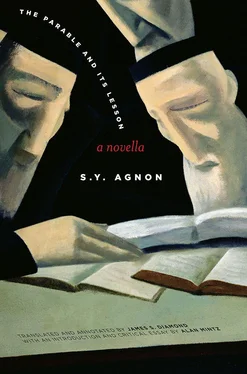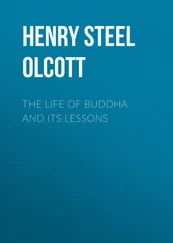This was a brand new directive that no rabbi had ever issued before, and he could see that it puzzled me. The rabbis of our town had never been concerned about this issue; nor for that matter had the rabbis of other communities. Our Master continued, “Our many sins compel us to live where we live and go where we go, and no one can be sure on what ground his feet are treading or where exactly he is standing. But a Sukkah, which epitomizes the mystery of the clouds of glory that God spread over Israel in the desert, requires a taintless spot on which to be erected, and we have to be very, very careful about that.” When our Master said, “and go where we go” I had the feeling that we were already on the way to the place where the young agunah’s husband was. Our Master gave me an approving look and indicated that our conversation was over.
On the way home I went over every word I had heard. How good it is to know that we have leaders whose words keep us on the straight path and sustain us in this Exile.
I came home and began making preparations for the Sabbath. Not only what was needed in the synagogue but at home as well, for my wife, may she rest in peace, was quite weak and could hardly stand on her feet. After the Sabbath I turned to Yom Kippur preparations. God’s mercies were with us, because the holy day passed without incident. No one fainted from the fast, those who led the service did not stray from the proper melodies, the Torah reader made no mistakes in chanting the text. Not a single candle went out, neither those lit for the living nor those lit for the dead. There were so many candles that they all melted together. A great many people had perished in the slaughter and their surviving relatives lit candles in their memory. Our Master lit many for his own family. The only one left was that little girl now in limbo because of the sin her husband committed.
The next day I brought over to our Master the silver case in which he kept his etrog. Every year my first wife, may she rest in peace, would polish it in honor of the approaching festival. She always did this between Rosh Hashanah and Yom Kippur. That year, because she was not well, she waited until the day after Yom Kippur. This meant a change in our Master’s routine, for it was his custom in the evening, at the end of Yom Kippur after havdalah, to take out his etrog and put it in its case. Our Master did not even notice the change.
I entered to find him in the company of two men, the venerable magnate Reb Akiva Shas, so named because he was fortunate to own a complete set of the Talmud, and, like him distinguished in stature and character but not in wealth, Reb Meshullam, a Jew from Germany who was a descendant of the composer of the Akdamut hymn read on the festival of Shavuot. Old age had kept them from visiting the evening before, right after Yom Kippur, so they came the next day.
I put the etrog case down in front of our Master. He looked at it and remarked, “I understand your wife is in need of mercy from on high.” “Yes,” I said, “she is sick. And, thank God, we have a houseful of little children.” I expected our Master to make some kind of blessing for her recovery, but he did not. Only later did I understand why. He knew what we did not: that her end had already been ordained. She died that year. Our Master then placed the etrog in the case and left the case open.
The etrog gave off its fragrance as our Master resumed reminiscing with his two elderly visitors about bygone days, and in due course he told a story that, in the particular context, was disconcerting. There was a time when for many years etrogs were scarce and people began to worry that Jews would soon forget what an etrog was. One year, between Rosh Hashanah and Yom Kippur, two Jews from a distant country showed up with etrogs for sale. The community bought one at a very steep price. No one seemed to care that the community was mired in debt, having borrowed money from the local priests to ransom prisoners. Many doubted that the etrog was kosher or if one could even make the blessing over it. Nevertheless, everyone did, even the doubters, because the commandment to bless the etrog was very dear to them. After the Sukkot festival someone got the idea that the etrog should be examined. Everyone came to see. They cut it open and discovered that it was in fact a lemon, which meant that all the blessings made over it were in vain. Around Passover time, when the snow was melting, two corpses were found in the forest. Wolves had eaten them and nothing was left but bones and clothing. The clothing was examined and found to be that of the men who had sold the etrog. Whom to suspect of their murder? Not Jews, for even if they had known that the men had sold them a lemon instead of an etrog they would not have committed murder. Not God, for God does not execute judgment unjustly. They convened a beit din to look into the legal status of the wives of the dead men. Were they agunot or did the clothing found prove them to be widows? The question became moot when the wicked Khmelnitski’s pogroms erupted and many women were taken into captivity, including the widows of the etrog sellers.
Once his two visitors had gone, our Master showed me the passage in the talmudic tractate ’Eruvin where it says that Gehinnom has three openings: one in the desert, one in the sea, and one in Jerusalem. He also showed me another passage there that says that Gehinnom has seven names, and he explained to me the fine points of the differences between them. He concluded by telling me that since the destruction of Jerusalem not every wicked person has the merit of going down to Gehinnom from the opening that is in Jerusalem. For the majority of the wicked, Gehinnom opens right at their feet, under their very feet. He then taught me some laws relating to Gehinnom. But there was no mention of a visit there.
That night after the evening service I could see that our Master was staring at me. I went over to him but he said nothing. I stood and looked at him and saw that his face was burning and his white curls were glistening with sweat. Because of headaches that resulted from a sword wound, our Master never cut his hair, not even for Yom Kippur.
I stood before him but he paid no attention to me. I did not move. I thought to myself, he is not looking at me like that for no reason. He continued staring at me, when he said, “Take the lantern and let us set out.” Even though he did not say where we were going, I knew. Of course, when he said “let us set out” his actual words were “In the name of God, let us go.” I do not quote his exact words because any intelligent person knows that nothing is done without asking for God’s help first. Happy is he who asks and happy is he who is answered.
I now return to the main story.
I had with me candles made from the wax that dripped from the ones lit in the synagogue on Yom Kippur. I normally used them on Hoshana Rabba and on the twentieth of Sivan. In our Master’s time people did not run to catch the wax drippings from the Yom Kippur candles right after the concluding evening prayer. They were too intent on greeting our Master and getting a blessing from him. So the wax was mine for the taking. I took all the candles I had with me so that darkness would not engulf us if the journey would prove to be a long one. When a person is alive he cannot see that the pit of Gehinnom is open right in front of him. He goes on his way and has no idea that it is right in front of him. I put the candle into the lantern but had no need to light it, for all this happened between Yom Kippur and Sukkot and it was a bright night.
We went out to the courtyard of the synagogue. Our Master stood and checked the direction of the wind. He sniffed the breeze, got his bearings, and said, “Let us go.”
We passed the synagogues and came out behind the Strypa at the Butchers Street. From there we got to Ox Gore Street, so named because an ox once gored a woman and her children there. Today it is called King Street. From there we headed northwest.
Читать дальше












![Edward Ellis - Adrift on the Pacific - A Boys [sic] Story of the Sea and its Perils](/books/753342/edward-ellis-adrift-on-the-pacific-a-boys-sic-s-thumb.webp)